

On this Page
Introduction
Why Do This?
Projects
Historcal Facts Warning
Chilterns timeline
Writer Profiles:
Leigh Axe
Keith Bowler
Dennis Claydon
Gordon May
Rosemary Mortham
Rita Probert
Laurence Rostron
Doug Tilbury
Joan West
Lacey Green is a thriving village, closely associated with the other hilltop villages of Loosley Row, Speen, and the hamlets of Parslows Hillock, Highwood Bottom, Turnip End, Coombs and Flowers Bottom.
For present day residents, it is a good place to live, a bit expensive, but with a fantastic school, and within commuter range of London. There are many clubs and societies, a wonderful environment and friendly residents, so what more could you want?
But it wasn't always like this. Life without gas and electricity; when the soil was heavy clay; when there was only natural water and the area was really only useful for growing trees and hunting game with a few small areas cleared for arable crops, is hard to imagine today.
Lacey Green and Loosley Row both developed from small hamlets. The way in which they developed was driven by a few visionary people, and they should not be forgotten.
They talk of snow this year but this was 1963 when villagers were cut off from outside services for several days.
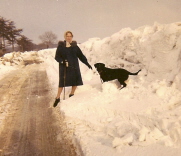
Has anyone got any memories they would like to share?
E-Mail: History
In the last 50 years the population has expanded dramatically, but some village families are still here, and they have a tale to tell.
If you have an enquiring mind, have bought an old house or just love mysteries, there's a start. Three friends originally, now six, the members of the Village History Group - have long dreamed of preserving what is known of the history of Lacey Green and Loosley Row, before the old ways are completely forgotten.
They have been working on different aspects of this for a long time keeping in touch and sharing information, but not publishing their knowledge. Then came the Internet, so now here it is with absolutely no cost to the world for access!
A picture with many gaps is being painted. If you have information to add or can make corrections we would like to here from you!
Information and exhibits can come to light at any time - this picture/postcard below was discovered as recently as 2023 at an antiques fair by Beckie and Graham Howson - thank you. It shows Sunnybank (1/2) and what is now Collins Cottage (previously two cottages - Deep Vale?).
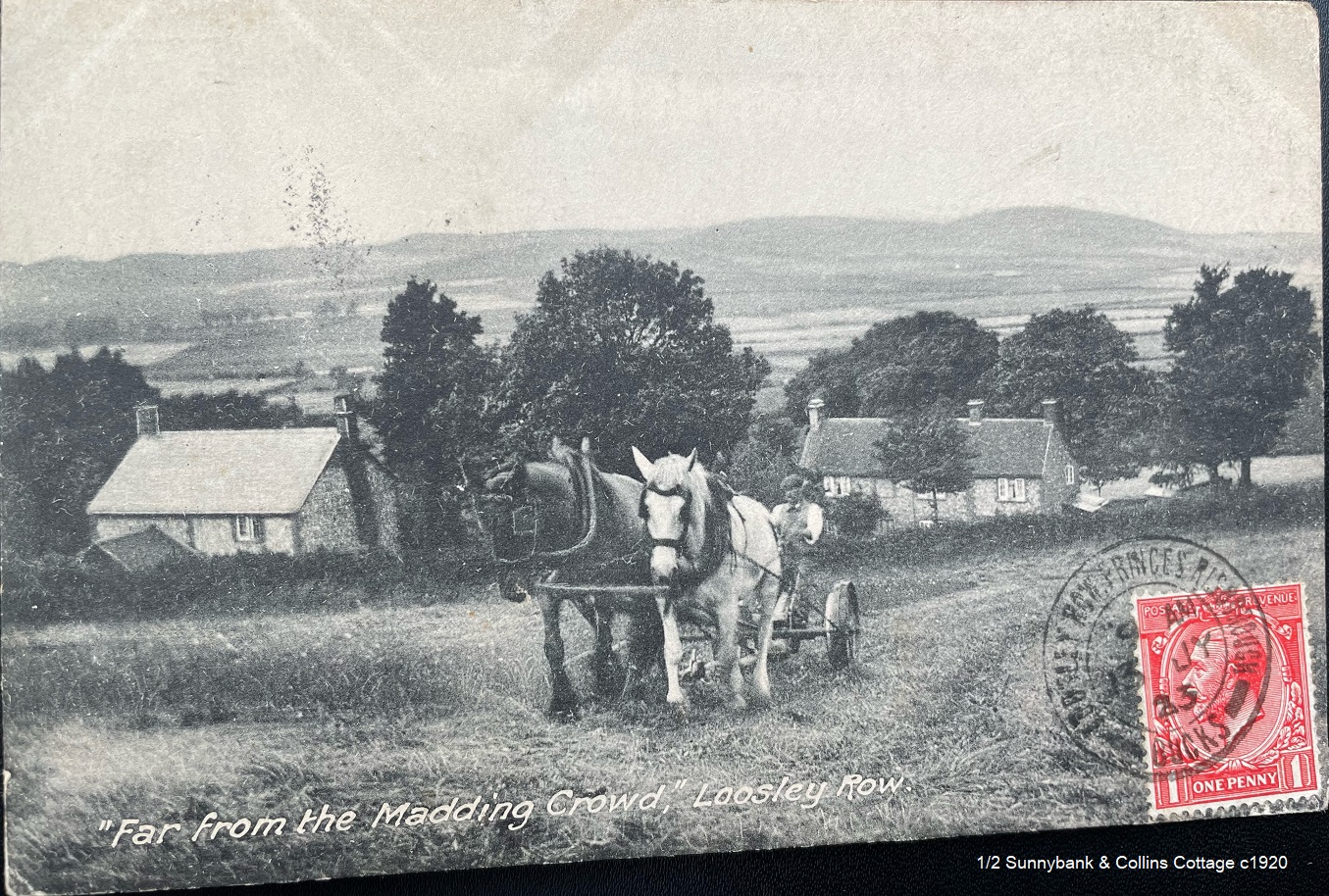
You then discover there is still more information to be found as thus far we only have research on Loosley House in Lower Rd.
E-Mail: History
The aim in 2009 was that there has to be something that will interest you from the following areas we have (see Index in left column) or propose to write about:
The hope is that anyone interested in the history of our villages will enjoy reading about the subjects in which we have taken an interest. We have been adding these articles since the beginning of 2009.
Questions we are having difficulty in answering are:
The availability of historical facts depends on how far you go back. Its also a question of access to and the accuracy of the information avalable.
There was a time when nothing was written down.
Then it became limited to a few scholars and spelling became an issue. The people relating a story most likely couldn't write and spelling was based on 'sounds like'. Language also changes over time.
Not to mention the so called 'Chinese whispers' where "Send reinforcements we are going to advance" becomes "send three and fourpence we are gong to a dance" when told and retold.
During the reformation when Henry VIII had it in for catholics, what bias might they have applied to any gossip eminating from Royal circles.
Facts can be in short supply. In 2021 researchers believed they had discovered evidence that Richard III (recently found burried under a car park) might not be responsible for killing the 'Twins in the Tower'. The bodies were never found and the researchers believe they have evidence that one of them at least was sent to live in a Devon village under an assumed name. ? ? ?
Older history therefore is sometimes based on probability and inference, but then, the original Magna Carta still exists.
Records now are much more accurate but nothing is completely reliable, but we hope, more probable.
We now have five writers and researchers:
Joan has recently retired from being the farmers wife at Stocken Farm.
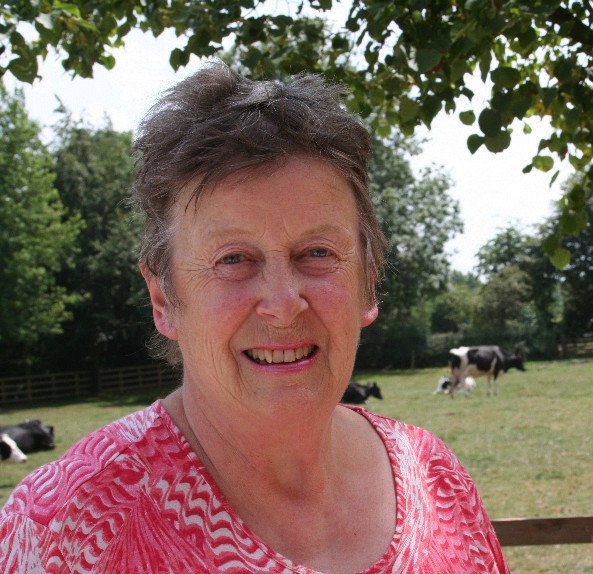
In 1971, while stripping out the 17th century farmhouse, she began to wonder exactly when it was built. She has yet to find the answer, but in tracing it back through owners and tenants, she became interested in the village families. Studying the school log books lead to publication of her book: "A Chiltern Village School". (download)
Witnessing the decline of old village families and often seeing critical information relating to the villages destroyed on bonfires, made her spring into action. She began to collect and make copies of photographs and deeds. She is grateful for the generosity of those she approached for the loan of these important pieces of history.
Local history became a hobby, which could easily become an obsession, but she says she just doesn't have the time!
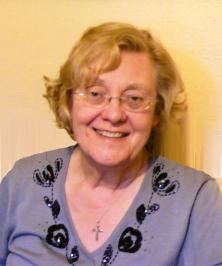
Rosemary Mortham (nee Oliver) was born in High Wycombe, and moved to the village at the age of six, soon after the second World War. She attended St. John's School, and now feels almost like a local.
She has long been interested in village history, especially the history of the church the school and bobbin lacemaking. She was concerned that there was no record of how the village used to be. She had heard many stories from old village folk, and realised that her fellow writers had a wealth of knowledge which could easily be lost.
When it was suggested that all this information could be put onto a village website, Rosemary saw the opportunity to encourage and cajole the three village historians to finally write up at least some of what they know. She is now an informal secretary to the group.
Rosemary looks forward to seeing the results of their many years of research, and feels sure that others will also enjoy reading it.

Rita was born in Ealing, West London and moved to Buckinghamshire with her parents in 1956. They were jokingly told then that 50 years would have to expire before being accepted as 'locals': that 'apprenticeship' has now been served!
From schooldays in London, Rita always had a very keen interest in history, which eventually progressed to genealogy. With more spare time on retirement after 25 years as secretary for the Thames Valley Police at Aylesbury, family history became almost a full-time occupation.
Since being invited to join the Lacey Green History Group, this has been further extended to include local history.
Rita enjoys living in Buckinghamshire, the countryside in general and is also a member of the local walking club.
Laurence was born in Sittingbourne in Kent before the 2nd World War and as a boy he watched the Battle of Britain, raiding German Bombers, local Anti-Aircraft guns, Doodle Bugs and the preparations for D Day. A somewhat unusual background to his early days.

Linda and Laurence were married in 1968 and their first house was in Loosley Row but in 1975 they moved to Lacey Green and they have lived there ever since.
In spite of significant overseas business travel Laurence found time to be the local Cub football coach, part time chairman of the Village Design Statement Committee and Chairman of the Village Residents Association.
In 2013 he started to work part time and as a reaction to various questions he decided to write a document on his memories of the 2nd World War and this started his interest in local history. He retired completely in 2017 so he then had even more time to attend a course on Local History at Oxford University, join the Village History Group, the Bucks Archaeology Society, Bucks History Association and research and write several new documents and articles.

Keith and his wife Elizabeth were both born and raised and lived in Ealing. For many years both were very involved in Amateur Dramatics, Drama Workshops and the theatre in general. During this time Keith also wrote stage plays, some of which were performed in local theatres. They have also lived in Surrey and for many years in Chalfont St. Peter, before moving to Lacey Green in 2017 where Keith became a Parish Councillor in 2021.
He has always been interested in local history, industrial/social history and history in general, especially military and historic aviation history. His interest in the RAF and historic aviation led him to writing two published novels, writing under the name of C. S. Peters.
These novels: On a Wing and a Prayer and Ever Present Danger, involved several years of research including many recorded interviews. These interviews were with individuals such as: former RAF aircrew and groundcrew; former members of the French and Belgian Resistance; former members of the SOE; Evacuees; former members of the Fire Brigade in London during the Blitz.

Born Lincolnshire 1946, raised Yorkshire. Worked in London from 1968 where he met Yvonne and they married in 1971. Two sons followed. In the early 80's the kids were given an 'Acorn BBC Micro Model B' part of the BBC's computer literacy project - Leigh became literate - these were the days when you went and made a cuppa while an App loaded.
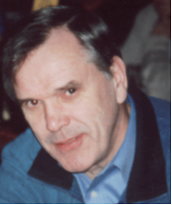
He went on to write training programmes for the Met Police, where students learnt a subject by sitting at a computer. He earned an MSc in Interactive Systems Analysis which, he says, usually stops the conversation.
Retired first time in 1996 and he and Yvonne went to live in USA. Returned after 5 years, just couldn't live with US culture.
Got a College job in Kent teaching teenagers, retired again in 2006. Came to this area looking for a house near/between the kids. Settled in Lacey Green having got fed up of looking.
Joined in village activities. Helps maintain Lacey Green website and uploads all the History researched by the group.
Douglas Tilbury was born in 1934 at No.1 Hillock Cottages, Lily Bottom Lane.

He started school at St. John's, Lacey Green in 1939, at the outbreak of World War II. He later attended Mill End Road School in High Wycombe. After that he began work for his father on their small tenanted farm at Parslows Hillocks.
He was called up for National Service in the R.A.F., and became an Engine Mechanic (Turbine) with 56 Squadron, working on the Meteor Mark VIII.
When demobbed back to the family farm, he began working for a contractor on hedge trimming and combining, and later developed his own business.
Douglas was on the Parish Council for 8 years, and the P.C.C. for 20 years. He was a Churchwarden for 10 years.
He retained his keen interest in World War II aviation, especially local flying activities. He was a member of the Royal Air Force National Service Association. He was a founder member of the Princes Risborough and District Historical Farm Machinery Club.
His family has local links, which go back many generations.
He told us many stories of teasing the local policeman, working with the bodgers, local feuding involving his own family; not to mention Bomber Harris landing on Main Road. And there was the time he nearly burnt down the Village Hall
Doug made many other contributions to the History pages of Lacey Green Website and other sites, here are a few:
Lacey Green Aifield
The Bodgers
The Home Guard
Lacey Green village policeman
Sadly we lost Doug in 2022.
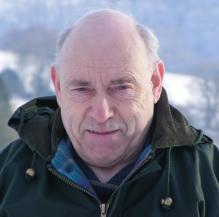
Dennis couldn't claim to be a true local, since he was not born in Lacey Green. However, he has spent most of his life in the village. He started school at St. John's, and later transferred to High Wycombe.
Members of the Claydon family have resided in Lacey Green for well over 200 years. This stimulated in Dennis, from a very early age, an interest in local history. From the initial examination of family documents his hobby had led to a far wider study of general village history. His pursuit continued to grow over the years and he had done considerable research whenever time would allow.
He was a member of Princes Risborough Area Heritage Society, Risborough Countryside Group and the Bucks Family History Society. Lately he was a serving member on Lacey Green Parish Council, a position which he held for over 20 years.
Sadly Dennis died on Friday 13 November 2016 aged 73 just after he finished a

Gordon was born in 1933, the youngest of three boys. They lived in the little hamlet of Darvills Hill between Lacey Green and Speen, in a house with no gas, electricity, mains drainage or running water.
He attended Lacey Green School from the age of 4 to 14, throughout the 2nd World War, and he belonged to the Local Boy Scout Troop.
From an early age he attended Lacey Green Methodist Chapel and as an adult, he held several church offices. When the building was closed in 2001, he had been a member for 70 years, 37 of them as Superintendant of the Sunday School.
Gordon also played football and cricket for Lacey Green for many years.
For the whole of his working life he was employed in the retail trade in High Wycombe.
Sadly, we lost Gordon in January, 2014.
About a hundred million years ago what is now Lacey Green, along with the rest of the Chilterns and most of Britain, was lying on the bed of a shallow sea. In fact the chalk which makes up the body of the Chilterns was formed over a period of millions of years by the skeletons of microscopic sea creatures, which rained down on the sea bed. The inhabitants of this lost sea, including shells, sea urchins, sponges and sharks, can still be found locally today in the form of beautifully preserved fossils.
|
|
|
4,500,000,000 +
Solar system formed.
While the earth cooled, as it is still doing today, a massive glancing impact led to the moon's formation.
Oceans developed and a poisonous atmosphere.
3,800,000,000
Earliest signs of life.
2,400,000,000
Oxygenated atmosphere formed.
1,700,000,000
Earliest multi-cellular organisms.
1,400,000,000
Earliest known fungi.
600,000,000
Earliest known Cnidarians.
550,000,000
Cambrian explosion.
450,000,000
Earliest land invertebrates and plants
350,000,000
Earliest land vertebrates.
240,000,000
Earliest known dinosaur.
50,000,000
Extinction of non-avian dinosaurs.
3,000,000
Homo habilis evolved able to make tools but were more ape than human.
2,000,000
Homo erectus evolves in Africa. Learnt to work together.
500,000
People migrate to Britain from Europe.

Palaeolithic
(old stone age)
700,000-12,000 BC
Mesolithic
(middle stone age)
12,000-5,000 BC
Neolithic
(new stone age)
5,000-2,500 BC
Bronze Age
2,500-600 BC
Iron age
650 BC-43 AD